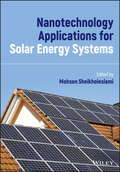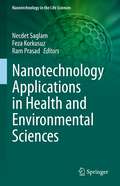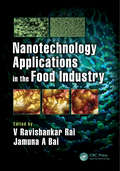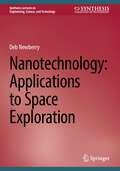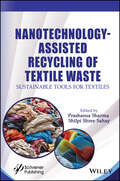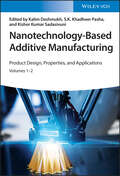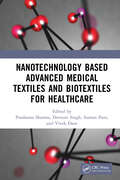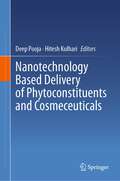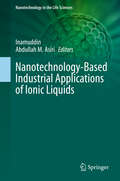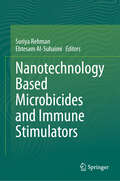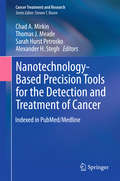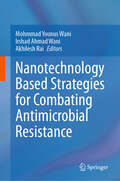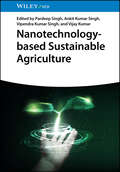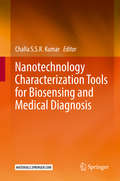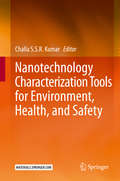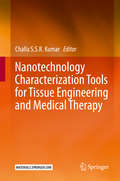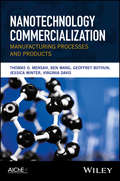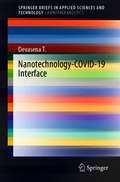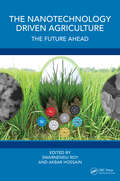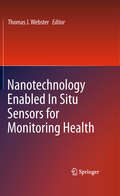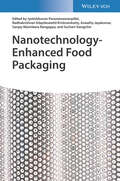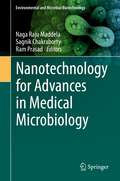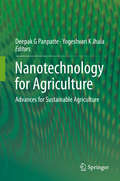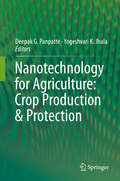- Table View
- List View
Nanotechnology Applications for Solar Energy Systems
by Mohsen SheikholeslamiNanotechnology Applications for Solar Energy Systems Understand the latest developments in solar nanotechnology with this comprehensive guide Solar energy has never seemed a more critical component of humanity’s future. As global researchers and industries work to develop sustainable technologies and energy sources worldwide, the need to increase efficiency and decrease costs becomes paramount. Nanotechnology has the potential to play a considerable role in meeting these challenges, leading to the development of solar energy systems that overcome the limitations of existing technologies. Nanotechnology Applications for Solar Energy Systems is a comprehensive guide to the latest technological advancements and applications of nanotechnology in the field of solar energy. It analyzes nanotechnology applications across a full range of solar energy systems, reviewing feasible technological advancements for enhanced performance of solar energy devices, and discussing emerging nanomaterials such as graphene and graphene derivatives. Nanotechnology Applications for Solar Energy Systems readers will also find: Detailed treatment of nanotechnology applications in systems including solar concentrating collectors, linear Fresnel reflectors, parabolic trough collectors, and more Coverage of methods to enhance the performance of solar energy devices including solar ponds and solar steam generators A comprehensive review of nanomaterials classification and the properties of nanomaterials in heat transfer and efficiency enhancement Nanotechnology Applications for Solar Energy Systems is critical for researchers in fields related to solar energy, engineers and industry professionals developing solar technology, and academics working in related fields such as chemistry, physics, materials science, and electrical engineering.
Nanotechnology Applications in Health and Environmental Sciences (Nanotechnology in the Life Sciences)
by Necdet Saglam Feza Korkusuz Ram PrasadNanoscience and nanotechnologies are leading to a major point to our understanding of nature. Nanotechnology can be generally defined as creation and use of nano-sized systems, devices, and structures which have special functions or properties because of their small size. This volume on Nanotechnology Applications in Health and Environmental Sciences focuses on biotechnological and environmental applications of nanomaterials. It covers popular and various nanomedical topics such as oncology, genetics, and reconstructive medicine. Additionally, many chapters give leading-edge information on nano-sensor applications and usage in specific disciplines. Also, two chapters on novel subjects have been included on Lantibiotics and microbiota. This book should be useful for nanotechnologists, microbiologists, and researchers interested in nanomedicine and nano-biotechnology, as well as environmental nanotechnology.
Nanotechnology Applications in the Food Industry
by V Ravishankar Rai Jamuna A BaiNanotechnology is increasingly used in the food industry in the production, processing, packaging, and preservation of foods. It is also used to enhance flavor and color, nutrient delivery, and bioavailability, and to improve food safety and in quality management. Nanotechnology Applications in the Food Industry is a comprehensive reference book containing exhaustive information on nanotechnology and the scope of its applications in the food industry. The book has five sections delving on all aspects of nanotechnology and its key role in food industry in the present scenario. Part I on Introduction to Nanotechnology in Food Sector covers the technological basis for its application in food industry and in agriculture. The use of nanosized foods and nanomaterials in food, the safety issues pertaining to its applications in foods and on market analysis and consumer perception of food nanotechnology has been discussed in the section. Part II on Nanotechnology in Food Packaging reviews the use of nanopolymers, nanocomposites and nanostructured coatings in food packaging. Part III on Nanosensors for Safe and Quality Foods provides an overview on nanotechnology in the development of biosensors for pathogen and food contaminant detections, and in sampling and food quality management. Part IV on Nanotechnology for Nutrient Delivery in Foods deals with the use of nanotechnology in foods for controlled and effective release of nutrients. Part V on Safety Assessment for Use of Nanomaterials in Food and Food Production deliberates on the benefits and risks associated with the extensive and long term applications of nanotechnology in food sector.
Nanotechnology: Applications to Space Exploration (Synthesis Lectures on Engineering, Science, and Technology)
by Deb NewberryThe convergence of 1) the intensification of space exploration and 2) the increasing understanding of the world at the atomic and molecular level, nanotechnology, has resulted in a synergy of discoveries and innovations. The result of this synergy may result in leaps in the exploration beyond the surface of the earth but also improve life on our home planet. The content describes the challenge of escaping the earth’s surface, remaining in orbits around our planet, and landing and surviving on worlds away. The associated space environments and variables are covered in general terms and not in an encyclopedic manner. Discoveries in the nanotechnology arena as they can be applied to space exploration are also covered in an understandable manner. This book is a must for people who are working in the “space” industry who need to know not only more about the many aspects of their industry but also must understand nano-scale implications for the future. Likewise, participants in the nanotechnology arena who want to understand the challenges of space exploration will find critical information in this text.
Nanotechnology-Assisted Recycling of Textile Waste: Sustainable Tools for Textiles
by Prashansa Sharma Shilpi Shree SahayDiscover how innovative nanotechnology can turn waste into opportunity, offering insights and strategies to create a greener, more eco-friendly textile industry. This book investigates nanotechnology-assisted sustainable solutions and their potential to transform waste into opportunity by fostering innovative designs and in-depth knowledge of sustainable waste management and nanotechnology applications. Divided into four comprehensive parts, comprising 16 chapters, Nanotechnology Assisted Recycling of Textile Waste, provides insights into the potential of nanotechnology in revolutionizing textile recycling and shaping the future of sustainable textiles. Part I sets the stage with an insightful overview of textile waste and management, exploring the conceptual dimensions and challenges in handling and organizing textile waste. It also describes the innovative realm of textile recycling. In Part II, the spotlight shines on comprehensive, sustainable, and productive recycling of waste using nanotechnology. Here, readers are invited to explore the transformative contributions of nanotechnology in shaping sustainable textile design and characterizing functional properties of novel recycled nano-textiles. Future perspectives of nanotechnology in textile applications, particularly concerning waste recycling, are also examined. Part III explores deeper into the advanced application of recycled and nano-assisted novel textiles generated through waste. From sports textiles to technical textiles, this section explores the diverse applications of recycled waste, bolstered by nano-engineered innovations. Finally, Part IV addresses the critical aspects of quality control and regulatory compliance in the realm of advanced nano-textile materials through an exploration of global legislation, schemes, and standards. Readers will find in this book: research findings and innovative approaches to cope with the challenges and issues of textile waste; systematic and scientific knowledge on textile waste recycling techniques using nanotechnology; knowledge of complex scientific research findings in a simple and understandable form; comprehensive coverage of a broad range of topics, including sustainable textile waste management. Audience The book will be read by a range of researchers, engineers and students in technical textiles, textile technology and engineering, textile chemistry, fiber science, textile processing technologies and manufacturing, fashion and apparel technology, materials science, environmental science. This book will help designers and clothing manufacturers, and all those in textile and environmental domains, who are engaged in waste management.
Nanotechnology-Based Additive Manufacturing: Product Design, Properties, and Applications
by Kalim DeshmukhNanotechnology-Based Additive Manufacturing State-of-the-art overview of additive manufacturing techniques with an emphasis on processes, product designs and applications This book offers a thorough overview of additive manufacturing technologies, including manufacturing requirements, product design, optimization of processes and product parameters to reduce manufacturing costs. It provides a comprehensive and state-of-the-art review on various additive manufacturing technologies, their advantages, shortcomings, potential applications and future directions. Sample topics discussed by the three well-qualified editors on the topic of additive manufacturing include: Areas of application in the fields of electronics, aerospace, construction, automobile, sports and biomedicine Material considerations, the requirement of specific design, fabrication and processing methods Advantages and disadvantages of various 3D printing techniques for the respectively intended applications This book is an immensely valuable resource for researchers working in the field of additive manufacturing or 3D printing, or for developers dealing with the processing and manufacturing of materials and products for advanced technologies.
Nanotechnology Based Advanced Medical Textiles and Biotextiles for Healthcare
by Vivek Dave Prashansa Sharma Devsuni Singh Suman PantThis book provides systematic coverage of research into medical and biotextiles based on nanomaterials as applicable in healthcare. Divided into three sections, it explains manufacturing, properties, types, and recent developments in nanotechnology based medical textiles backed by case studies. It includes a wide range of different clinical applications of biotextiles for healthcare including nanotextile scaffolds, nano-based artificial organs, surgical sutures, enzymatic assisted enhanced biotextiles, tissue engineering or drug delivery system via nanofibers, and so forth.Features: Provides strong and broad overview of medical applications in the field of nano and biotextiles. Highlights different approaches, recent research, and emerging innovations. Covers designing or developing nanomaterials based antiviral surface disinfectants with self-cleaning property. Reviews different applications of nano based medical textiles such as deodorizing or pH control clothing for hygiene maintenance. Includes the real-life applications based descriptive case studies that offer a diverse range of perspectives. This book is aimed at researchers and graduate students in textile technology and engineering, and medical textiles.
Nanotechnology Based Delivery of Phytoconstituents and Cosmeceuticals
by Deep Pooja Hitesh KulhariThis book explores the role of nanotechnology in the delivery of natural phytoconstituents and cosmeceuticals. It presents polymeric nanocarriers, lipid-based nanocarriers, metal/metal oxide nanocarriers, protein nanocarriers, and dendrimers for the delivery of phytoconstituents. Further, it focuses on the usage of phytocompounds in various cosmeceutical products and nano delivery technologies used in the delivery of various cosmeceuticals. Finally, the book reviews the toxicity issues of nanoparticles in the delivery of phytoconstituents and cosmeceuticals and regulatory aspects for clinical applications of nano phytomedicines. This book is helpful for academicians and researchers working in pharmaceutical sciences, nano science, material science, plant science, and cosmetic science.
Nanotechnology-Based Industrial Applications of Ionic Liquids (Nanotechnology in the Life Sciences)
by Inamuddin Abdullah M. AsiriNumerous solvents used in chemical processes have poisonous and unsafe properties that pose significant ecological concerns ranging from atmospheric emissions to the contamination of water effluents. To combat these ecological threats, over the course of the past two decades, the field of green chemistry has grown to develop more natural reaction processes and techniques involving the use of nonconventional solvents to diminish waste solvent production and thus decrease negative impact on the environment. Ionic liquids in particular are more environmentally friendly substitutes to conventional solvents, and as such, have seen more widespread use in the past decade. They have been used in such processes as extraction, separation, purification of organic, inorganic, and bioinorganic compounds, reaction media in biochemical and chemical catalysis, green organic and drug synthesis, among other industrial applications. Thus, in proving themselves a suitable greener media for economic viability in chemical processes, ionic liquids are leading to more sustainable development. This edition explores the application of ionic liquids as a green solvent. It contains a state-of-the-art overview on ionic liquids as green solvents for chemical processes and techniques, as well as some of their useful industrial applications.
Nanotechnology Based Microbicides and Immune Stimulators
by Suriya Rehman Ebtesam Al-SuhaimiThis book reviews the use of nano-based drug delivery systems and biomaterials to enhance the immune system against infectious diseases. It focusses on the inbuilt immunoreactive properties of nanomaterials and the advancement in its engineering to modulate the immune system either via immune-stimulation or immunosuppression. The book further discusses the use of nanoparticle-based vaccines to improve vaccine efficacy, immunization strategies, and targeted delivery to achieve desired immune responses at the cellular level against infectious diseases. Perhaps, book focusses on nanoscale diagnostics that offer new approaches for sensitive health monitoring that are potable and can guide the use of nanoscale therapies. This book explores the potential of immunomodulatory nanotechnologies, focusing not only on their benefits, but also on biocompatibility, and toxicity concerns, while highlighting promising innovations in Interferon-based immune therapies and addressing key challenges in achieving safe, scalable nanotech products. The book would encompass broad topics to attract the diverse specialty of physicians, health professionals, students, faculty, and researchers of nanotechnology, nanomedicine, infectious diseases, public health, immunology, bacteriology, virology, pathology, biotechnology, toxicology, and biomedical technology.
Nanotechnology-Based Precision Tools for the Detection and Treatment of Cancer
by Chad A. Mirkin Thomas J. Meade Sarah Hurst Petrosko Alexander H. SteghThis book discusses emerging nanotechnology-based tools that have the potential to dramatically impact cancer research, diagnostics, and treatment. Cancer is a complex, devastating, and debilitating disease and, although much progress has been made, novel, more effective diagnostic and treatment options are still needed, especially for advanced cancers. The ultimate goal is to detect cancer early and non-invasively and to provide efficacious and targeted precision treatments that cause fewer harmful side effects. This book explains how nanotechnology can exploit the size-, shape-, and composition-dependent properties of nanomaterials to provide novel tools for precision cancer medicine. It will be of interest to researchers and professionals working in the fields of chemistry, biology, materials science and engineering, and medicine who want to learn more about this fascinating and fast-paced area of research.
Nanotechnology Based Strategies for Combating Antimicrobial Resistance
by Mohmmad Younus Wani Irshad Ahmad Wani Akhilesh RaiThis book provides a comprehensive overview of recent advances in nanotechnology as an alternative strategy for addressing antimicrobial resistance (AMR). Examining nanotechnology-based methods such as nanoencapsulation, drug delivery, and conjugation, the text highlights their successful application in treating microbial infections with reduced resistance and off-target toxicity. The introductory section outlines AMR and explores diverse mechanisms of microbial resistance, emphasizing the potential of nanotechnology to surmount these challenges. Subsequent chapters investigate the role of specific nanomaterials—metal nanoparticles, metal oxide nanoparticles, functionalized quantum dots, magnetic nanoparticles, bimetallic nanoparticles, nanocomposites, carbon nanomaterials, and polymer-based nanomaterials—in overcoming antimicrobial resistance. Several chapters focus on the efficacy of nanoemulsions as an antimicrobial delivery method, underscoring their inherent antimicrobial properties, capacity to enhance drug solubility, stability, bioavailability, and targeting potential at the organ and cellular levels. The concluding section provides a detailed review of liposomes, dendrimers-based nanoparticles, and micelles as drug delivery vehicles in the context of combating pathogens resistant to antimicrobials.
Nanotechnology-based Sustainable Agriculture
by Pardeep Singh Ankit Kumar Singh Vipendra Kumar Singh Vijay KumarProvides detailed guidance on harnessing nanotechnology for sustainable agriculture, combines theoretical frameworks with actionable strategies Nanotechnology-based Sustainable Agriculture offers an in-depth exploration of how nanotechnology is revolutionizing agricultural practices to enhance crop productivity and environmental sustainability. Addressing key challenges in conventional agriculture, this volume presents the cutting-edge roles of various nanomaterials, such as carbon nanotubes and quantum dots, in boosting efficiency and reducing environmental impact. Emphasizing practical solutions, ranging from nano biofertilizers and nanobioremediation to innovative pest control strategies, an expert panel of authors provides a roadmap for integrating nanotechnology into sustainable agricultural systems. In-depth chapters describe both the fabrication of nanomaterials and their application in soil quality assessment, pollutant remediation, and crop disease management. Throughout the text, the authors highlight opportunities and address challenges to ensure the safe and effective adoption of these technologies. Enhancing crop productivity and environmental health through innovative solutions, Nanotechnology-based Sustainable Agriculture: Explores a wide range of nanotechnologies for use in agriculture, including plant-based nanomaterials, chitosan nanoparticles, and silver nanoparticlesPresents strategies for minimizing environmental and health impacts while maximizing crop productivityIncorporates the latest developments in nanobiotechnology, phytonanotechnology, and nano-bioremediationDiscusses the challenges and potential risks of nanomaterial-based chemicals in agricultural systemsExamines diverse case studies and strategies to achieve food security and sustainable agriculture on a global scale Nanotechnology-based Sustainable Agriculture is essential reading for advanced students, researchers, and professionals in environmental science, material science, and agriculture. It is well-suited as a textbook for graduate and postgraduate courses in sustainable agriculture or nanotechnology, as well as a reference for professionals in research and development, policymaking, and industry.
The Nanotechnology Challenge
by David A. DanaNanotechnology is the wave of the future, and has already been incorporated into everything from toothpaste to socks to military equipment. The safety of nanotechnology for human health and the environment is a great unknown, however, and no legal system in the world has yet devised a way to reasonably address the uncertain risks of nanotechnology. To do so will require creating new legal institutions. This volume of essays by leading law scholars and social and physical scientists offers a range of views as to how such institutions should be formed. It is essential reading for anyone who may wonder how we can continue to innovate technologically in a way that both delivers the benefits and sustains human health and the environment.
Nanotechnology Characterization Tools for Biosensing and Medical Diagnosis
by Challa S.S.R. KumarEighth volume of a 40 volume series on nanoscience and nanotechnology, edited by the renowned scientist Challa S.S.R. Kumar. This handbook gives a comprehensive overview about Nanotechnology Characterization Tools for Biosensing and Medical Diagnosis. Modern applications and state-of-the-art techniques are covered and make this volume an essential reading for research scientists in academia and industry.
Nanotechnology Characterization Tools for Environment, Health, and Safety
by Challa S. S. R. KumarTenth volume of a 40 volume series on nanoscience and nanotechnology, edited by the renowned scientist Challa S.S.R. Kumar. This handbook gives a comprehensive overview about Nanotechnology Characterization Tools for Environment, Health, and Safety. Modern applications and state-of-the-art techniques are covered and make this volume an essential reading for research scientists in academia and industry.
Nanotechnology Characterization Tools for Tissue Engineering and Medical Therapy
by Challa S. S. R. KumarNinth volume of a 40 volume series on nanoscience and nanotechnology, edited by the renowned scientist Challa S.S.R. Kumar. This handbook gives a comprehensive overview about Nanotechnology Characterization Tools for Tissue Engineering and Medical Therapy. Modern applications and state-of-the-art techniques are covered and make this volume an essential reading for research scientists in academia and industry.
Nanotechnology Commercialization: Manufacturing Processes and Products
by Thomas O. Mensah Ben Wang Geoffrey Bothun Jessica Winter Virginia DavisA fascinating and informative look at state-of-the-art nanotechnology research, worldwide, and its vast commercial potential Nanotechnology Commercialization: Manufacturing Processes and Products presents a detailed look at the state of the art in nanotechnology and explores key issues that must still be addressed in order to successfully commercialize that vital technology. Written by a team of distinguished experts in the field, it covers a range of applications notably: military, space, and commercial transport applications, as well as applications for missiles, aircraft, aerospace, and commercial transport systems. The drive to advance the frontiers of nanotechnology has become a major global initiative with profound economic, military, and environmental implications. Nanotechnology has tremendous commercial and economic implications with a projected $ 1.2 trillion-dollar global market. This book describes current research in the field and details its commercial potential—from work bench to market. Examines the state of the art in nanotechnology and explores key issues surrounding its commercialization Takes a real-world approach, with chapters written from a practical viewpoint, detailing the latest research and considering its potential commercial and defense applications Presents the current research and proposed applications of nanotechnology in such a way as to stimulate further research and development of new applications Written by an all-star team of experts, including pioneer patent-holders and award-winning researchers in nanotechnology The major challenge currently faced by researchers in nanotechnology is successfully transitioning laboratory research into viable commercial products for the 21st century. Written for professionals across an array of research and engineering disciplines, Nanotechnology Commercialization: Manufacturing Processes and Products does much to help them bridge the gap between lab and marketplace.
Nanotechnology-COVID-19 Interface (SpringerBriefs in Applied Sciences and Technology)
by Devasena T.This book highlights the role of nanotechnology concepts in the management of COVID-19 pandemic. The book covers different aspects of the causative agent SARS CoV2 (Severe Acute Respiratory Syndrome Coronavirus-2) and the COVID-19 pandemic with a special emphasis on nanotechnology. It discusses the origin and history of SARS CoV2 and the outbreak of COVID-19 and highlights the geographical mutations in the SARS CoV2 virus genome, providing information about the structural features, antigenicity and the life cycle of SARS CoV2. The book provides an insight into nanotechnology–virology interface and explains how nanomaterials link the gap between the vital phases of SARS CoV2 life cycle and the four modalities of COVID-19 management viz sensing/diagnosis, therapy, prevention and self-protection. Further, the existing and promising diagnostic tools for detection of COVID-19 are discussed with an emphasis on nano PCR, nanoimmunosensors, biobarcode assay and point of care approach and also describe the nanoparticles involved in the CT imaging of lungs and SFHI (Spatial Frequency Hetrodyne Imaging) for diagnosis of SARS COV2 infection. The book concludes with details about translational medicine and explains the types of SARS CoV2 vaccines, stages of COVID-19 vaccine development and possible nanovaccines for COVID-19, followed by the description on biopharmaceutical companies involved in the production of SARS CoV2 vaccines.
The Nanotechnology Driven Agriculture: The Future Ahead
by Swarnendu Roy and Akbar HossainNanotechnology is believed to accelerate our fight to sustain and enhance crop productivity for the ever-increasing world population. It has been reckoned as one of the safest and most cost-efficient techniques to boost crop productivity in the future. The ever-increasing state-of-the-art availability of various nanomaterials has allowed us to pursue their beneficial properties in agronomy. Nanotechnology will help minimize the dependency on chemical fertilizers and existing crop production techniques that have already been exploited to their maximum potential. Therefore, in the present context, it could well be realized that agriculture will be driven by nanotechnology in the future.This book focuses on the application of nanotechnology for enhancing crop production through the application of nanofertilizers or nanocomposites. Several avenues of nanotechnology are beneficial in improving crop productivity in a sustainable manner, which has been presented in a comprehensive way. The book also delves into the mechanistic view of nanoparticle functioning and its role in stress alleviation. In addition, the book presents some recent insights into the application of nanotechnology for post-harvest management, stress tolerance and usage as nanobiosensors.Broadly, the book will encompass the following advances in the field, distinguishing it from other published volumes. The salient features include:· Role of nanoparticles in improving abiotic stress tolerance in plants.· Role of nanoparticles in protection against pathogens and pests.· Mechanism of nanoparticle-induced plant responses.· Synthesis and modification of nanoparticles to enhance their biological efficacy.· Prospects of nanofertilizers, nanoformulations, nanopesticides, etc., and their beneficial attributes.This book, therefore, presents this emerging topic and the most recent innovations in this field for postgraduate students, researchers and faculty members working in the fields of plant science, microbiology, biotechnology, agricultural sciences, etc.
Nanotechnology Enabled In situ Sensors for Monitoring Health
by Thomas J. WebsterNanotechnologies are now being applied to health monitoring. Until recently, there has been little research into how to use nanotechnology and sensors in health monitoring. Nanotechnology Enabled In Situ Sensors for Monitoring Health summarizes the research efforts to design sensors based on nanotechnology that can be placed into the body to monitor health. Nanotechnology is being used at an unprecedented pace to both diagnose and treat diseases, rather than conventional approaches that diagnose and treat diseases in a different manner.
Nanotechnology-Enhanced Food Packaging
by Jyotishkumar Parameswaranpillai Radhakrishnan Edayileveettil Krishnankutty Aswathy Jayakumar Sanjay Mavinkere Rangappa Suchart SiengchinNanotechnology-Enhanced Food Packaging Timely overview of functional food packaging made with nanotechnology and nanomaterials In Nanotechnology-Enhanced Food Packaging, a distinguished group of researchers delivers a comprehensive and insightful introduction to the application of nanomaterials in food packaging. This edited volume covers recent innovations—as well as future perspectives—in the industry and offers a complete overview of different types of nanomaterials used in food packaging. The book also discusses the use of nanoparticles in the development of active and functional food packaging and the related environmental and toxicological aspects. Featuring one-of-a-kind contributions from leaders in the field, Nanotechnology-Enhanced Food Packaging provides real-world solutions to food packaging challenges and considers the legislative and economic implications of new technologies. Among the new developments in nanotechnology-enhanced food packaging covered by the book are: Thorough introduction to biopolymers in food packaging systems and nanostructures based on starch, their preparation, processing, and applications in packaging Comprehensive explorations of chitosan-based nanoparticles and their applications in the food industry Practical discussions of active packaging systems based on metal oxide nanoparticles and an overview of higher barrier packaging using nano-additives In-depth examinations of the characterization techniques for nanostructures in food packaging Perfect for materials scientists, food technologists, and polymer chemists, Nanotechnology-Enhanced Food Packaging also belongs on the bookshelves of plastics technologists and allied professionals in the food industry.
Nanotechnology for Advances in Medical Microbiology (Environmental and Microbial Biotechnology)
by Naga Raju Maddela Sagnik Chakraborty Ram PrasadCombined fields of Microbiology and Nanotechnology have been most successful in providing novel solutions for protecting the health of humans and environment. This book covers the implications of nano-strategies to combat bacterial pathogens, applications of nanotechniques in microbiology, and innovative advances in the area of medical microbiology. Contents are divided into three sections -- Nanoscience in controlling bacterial pathogens, Nanoscience in Microbiology, Medical Microbiology. This volume is going to provide timely information about the technological advances of Nanoscience in the domain of Microbiology, with a special emphasis on Pathobiology. The book is a useful read for students and researchers in microbiology, nanotechnology and medical microbiology.
Nanotechnology for Agriculture: Advances for Sustainable Agriculture
by Deepak G Panpatte Yogeshvari K JhalaThe emergence of nanotechnology and the development of new nano-devices and nanomaterials open up opportunities for novel applications in agriculture and biotechnology. Nanotechnology has the potential to modernize the agricultural research and practice. Nanotechnology has gained momentum in agriculture sector during last decade, but still there are knowledge gap between scientific communities. This book comprise of holistic coverage about current developments in nanotechnology based sustainable agriculture. It contains sections focusing on each aspect of the implications of nanotechnology in different sectors of agriculture from crop production, soil fertility management, crop improvement etc. It also provides insight into the current trends and future prospects of nanotechnology along with the benefits and risks and their impact on agricultural ecosystems. This book emphasize on use of nanotechnology to reduce agrochemical usage via smart delivery system, increase nutrient use efficiency, improved water and nutrient management, nano-biosensors for management of plant diseases etc. The book provides thorough knowledge for dealing with current challenges of agricultural sector using nanotechnology based agricultural interventions. It will serve as reference literature for scientists, policymakers, students and researchers who are engaged in development of strategies to cope up with challenges of current agricultural systems and society.
Nanotechnology for Agriculture: Crop Production & Protection
by Deepak G. Panpatte Yogeshvari K. JhalaThe emergence of nanotechnology and the development of new nanodevices and nanomaterials have opened up exciting opportunities for novel applications in agriculture and biotechnology. Nanotechnology has the potential to modernize agricultural research and practice, but although it has gained momentum in the agriculture sector over last decade, there are still knowledge gaps between scientific communities. This book presents a comprehensive overview of current developments in nanotechnology-based sustainable agriculture. Focusing on various aspects of nanotechnology in different sectors of agriculture, such as crop production, soil fertility management and crop improvement, it offers insights into the current trends and future prospects of nanotechnology, along with the benefits and risks and their impact on agricultural ecosystems. It also highlights the use of nanotechnology to reduce agrochemical usage, to increase nutrient uptake efficiency and to improve water and nutrient management, and the use of nano-biosensors to manage plant diseases. The book is a valuable reference resource for scientists, policymakers, students and researchers who are engaged in developing strategies to cope with current agricultural challenges.
